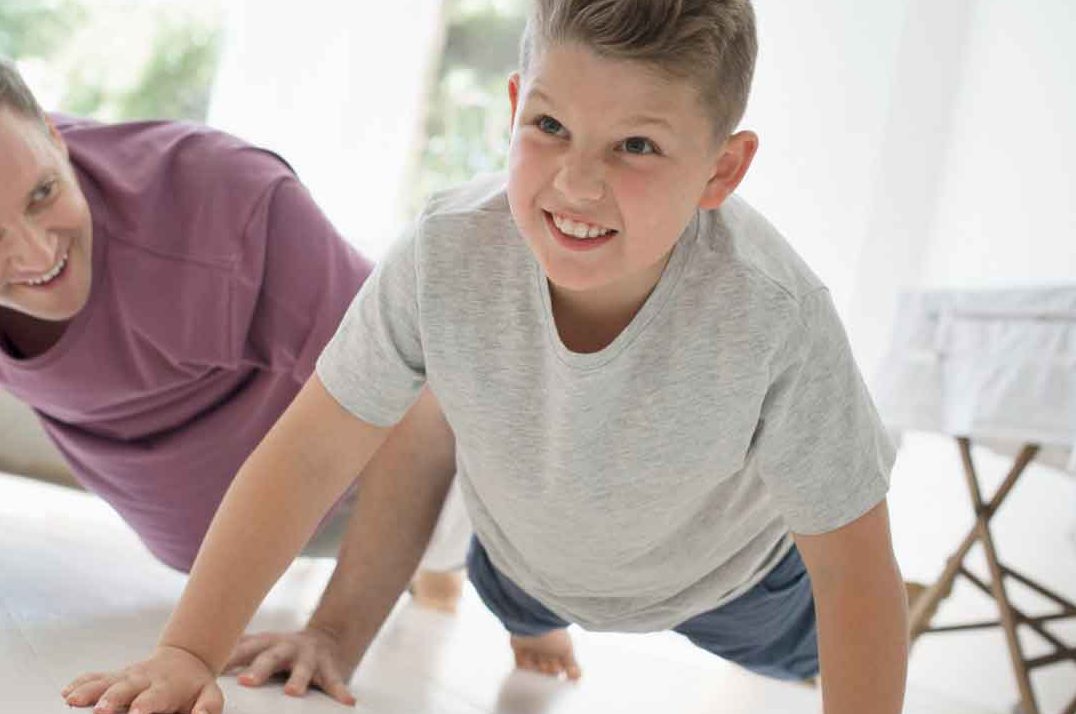Don’t Guilt Trip Your Kids About Exercise

Making your kids feel bad about their sloth-like behavior won’t change it, but encouragement from their peers might. Here's what you should know.
Haranguing middle-schoolers to exercise isn’t a winning strategy. You may have already come to that conclusion as your kids sit hunched over their video games, ignoring you.
Children normally decrease their activity levels by half between the fifth and sixth grades. But some decide on their own to become ballet dancers or basketball stars. If it’s their idea, research suggests, they’ll get moving. Much like adults, they need to see themselves as people who exercise.
Children and adolescents ages 6 through 17 need to be active for at least an hour a day. There are some ways to nudge them in that direction. It helps to start them young. You might skip the word “exercise” and just talk about “fun” or “play” or another related goal like getting to school.
If you have set rules limiting screen time (that includes TV, video games, and phone scrolling), it’s great when your child chooses to read a book, see a friend in person, or talk on the telephone. But you might create opportunities for your child to use that time for physical activity.
YOU MIGHT ALSO LIKE: The Effects of Skipping Breakfast on Your Child
Make activity built-in
One approach is to keep physical activity as a regular part of the day.
Can your child take responsibility for walking the dog at various times, including the morning? Can you make dog-walking a special time you and your child are alone together and talk about certain subjects? Can you make it their routine to play catch with the dog after school?
Can your preteen get to school by bike, on a skateboard, or on foot? How about the trip home? For younger children, consider taking turns with caregivers walking a group of kids to and from school.
If you like to take an online yoga or jazzercise class, can your child join you?
Take a walk as a family after dinner — ideally every Friday or perhaps Sunday, to round out the weekend.
If you watch TV together, do a couple of planks during the commercials or have a jumping jacks contest.
If you have set standards about keeping their rooms clean or doing other chores, look for ways to ramp up the activity. Suggest that they listen to dancing music on headphones when they’re vacuuming.
A middle-schooler might feel it’s special to help wash the car or fun to rake leaves with you or siblings. You can take the emphasis off activity and put it on contributing and taking responsibility.
Is your child responsible enough to pick up dinner ingredients at a store within walking distance? If your kids want ice cream, can you have them walk to the store to get it?
Maybe your garage is a mess. Dare your child to make a dent in the piles and offer a reward.
Make it social
Middle-schoolers are concerned about their social lives. Do they have friends on a sports team. Are they enrolled in sports camps? Are they drawn to particular kids who are active but don’t know how to get their attention?
You can let them know that the best way to fit in is to show up. The first step is the hardest.
Once they take the plunge, encouragement from peers may be more effective than adult nudging.
Children and teens often avoid exercise because they feel self-conscious about their weight or athletic ability. A self-conscious child might do best with activities that she can do alone or with family, like gardening or an after-dinner walk. But it’s important that she not feel pressured.
For group activities, start with small groups that focus on fun rather than competition. Your child might have one friend with whom she feels most safe. Perhaps that friend will join her in a dance class, or they can choreograph and practice a dance together at home and put on a show for you.
For boys attached to video games, you might suggest they try a video game that promotes fitness and challenge them to compete with you.
When kids take up a team sport, help them practice or ask them to show you what they’ve learned. Be sure to attend their events and cheer loudly. If your boys are musical, remember that playing the drums or a trumpet is a physical activity.
Walk the talk
Your own actions can show that it’s okay to be less than perfect. Join the neighborhood softball team with other parents and kids, even if you can’t bat or pitch. Put on a Michael Jackson video and try some moves yourself — while your spouse and children laugh at you. Then let them have a turn.
Commit to your own exercise program and convey that it’s fun and feels good. That may not feel true at first, but it could over time.
Why exercise is important
According to the American Heart Association, active kids are more likely to have:
- A healthy weight
- Stronger, healthier bones and muscles
- Better heart and brain health
- Improved brain function, including memory, attention, and problem-solving
- Better school attendance and academic performance, especially in math, reading, and writing
- Lower long-term risk of cardiovascular diseases, diabetes, and some kinds of cancer
- Less stress and fewer symptoms of anxiety and depression
- Less inappropriate and distracting classroom behavior
- Improved mental health and psychological well-being, including confidence and self-esteem
YOU MIGHT ALSO LIKE: Team Sports Can Boost Your Child’s Mental Health
Updated:
May 26, 2023
Reviewed By:
Christopher Nystuen, MD, MBA, and Janet O’Dell, RN